Dabu printing
Though resist printing can be produced in several ways, Dabu resist or mud resist is commonly practiced in Rajasthan. Therefore only this style of printing is discussed briefly. Dabu printing basically falls in the category of mechanical resist.
Print paste ingredients
- Black clay from ponds (Main ingredient for resist effect)
- Bidhan (Wheat powder obtained from the wheat eaten by wheat insects) Improve adhesion of print paste to block and fabric
- Gum Arabic (Improve adhesion of print paste to block and fabric)
- Lime water (prevent cracking of clay at the printed portion. Also improves adhesion of print to fabric)
Method of preparation of Dabu paste
The method varies from printer to printer.
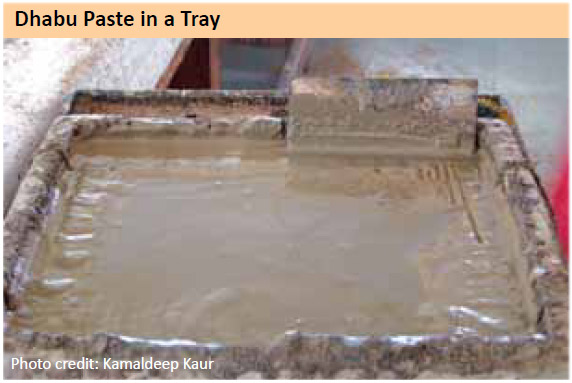
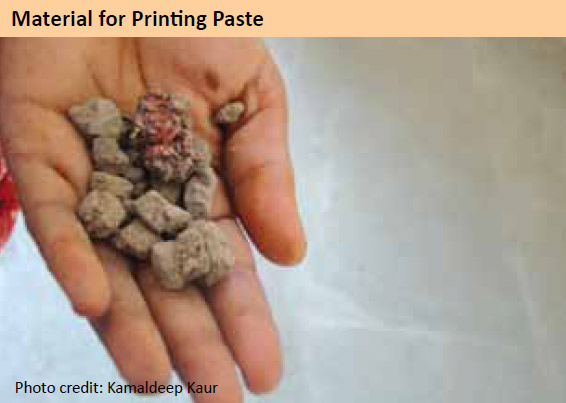
Printing: The Dabu paste is printed on fabric with the help of wooden block. A skilled printer is essential to get satisfactory prints.
Spraying of saw dust: Saw dust is then sprinkled manually on the wet Dabu print and left for few hours for drying. Good drying is essential otherwise the print may be removed during dyeing operation with the loss of resist effect.
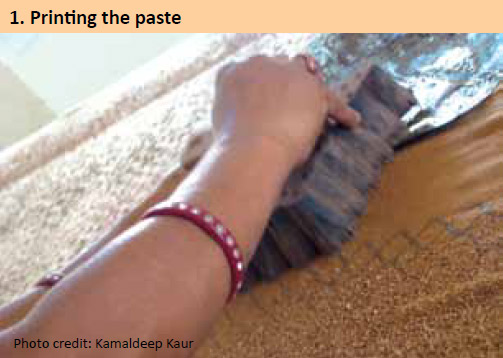
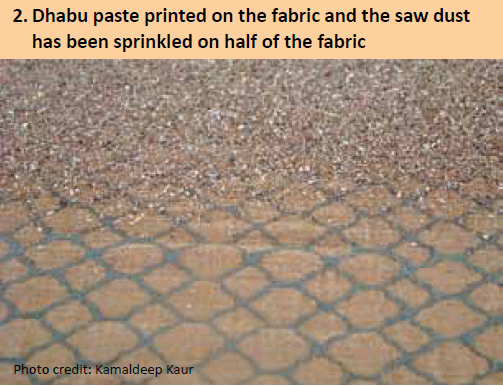
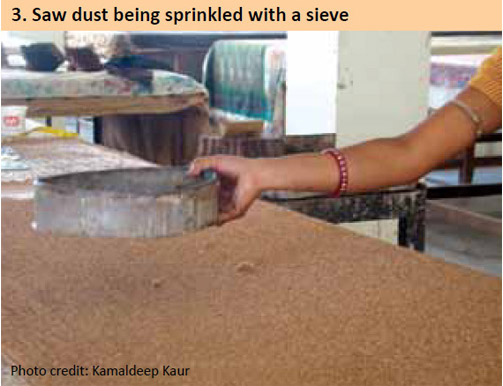
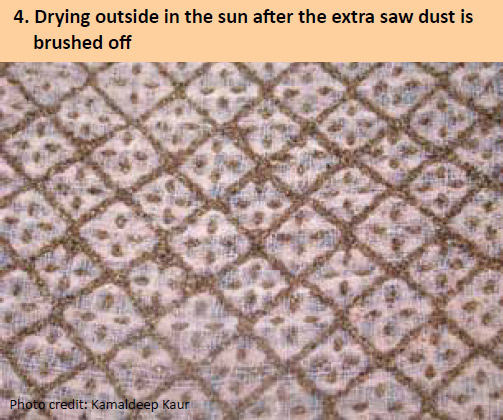
Dyeing: After printing and drying the fabric is then dyed in cold dye solution. Indigo dyeing is quite common. This would produce white print effect against blue background.
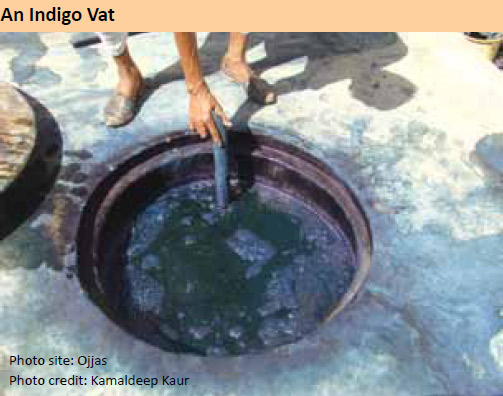
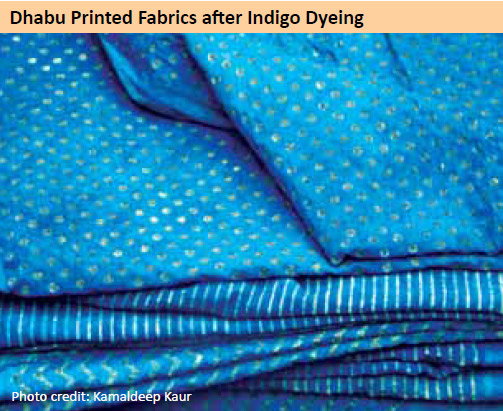
Dabu Printing after dyeing
After indigo dyeing if additional blue print effect is desired, then Dabu printing is repeated on resisted white prints and blue background and re-dyeing in second dye is done,
The Dabu printing and dyeing processes are repeated till the desired design is obtained. There are several variations of Dabu printing depending on the design. However, the basic principles remain the same.
Block printing with vegetable dyes
The natural or vegetable dye sources used in Rajasthan are shown in the following Table
Common vegetable dye sources25
| Local Name | Botanical name | Color produced |
|---|---|---|
| Dhak or Palas | Butea monosperma | Bright yellow |
| Casala | Carthamus tinctorium L | Golden yellow |
| Haldi | Curcuma Longa | Yellow |
| Neel | Indigofera tictoria | Blue |
| Manjistha or Madder | Rubia cordifolia | Red |
| Alizarin (Synthetic) | Red | |
| Nasphal | Punica granatum | Greenish yellow |
| Harda | Terminalia chebula | Greenish yellow |
Among these Harda, Alizarin, Indigo are most common.
In the event of non-availability of natural madder and indigo their synthetic counter parts i.e. chemical dyes are also used.
Many times a combination of direct and resist styles are
practiced depending on the design.
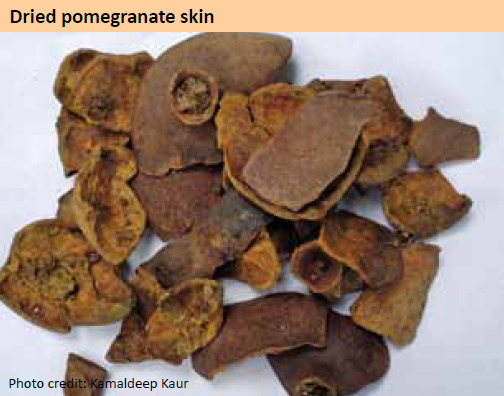
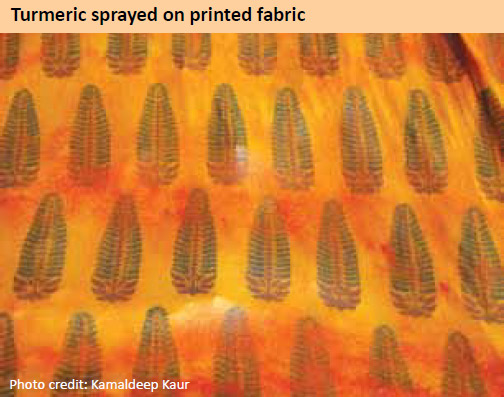
Production steps
- Scouring (Pre processing of fabric before printing) locally called “Hari Sarana”
- Tannin or preparing fabric for printing locally called “Peela Karna” or Harda Rangai.
- Printing with mordant salts locally called “Chapai”.
- Drying of printed fabric or Ageing before dyeing the fabric in natural dye locally called “Sukhai”.
- Washing or removal of excess mordant before dyeing locally called “Khulai”.
- Dyeing or fixing of colours after washing locally called “Rangai”.
- Resist Printing or mud clay printing locally called “Dabu Datai”
- Dyeing with blue colour locally called “Neel Rangai”.
- Dyeing with yellow dye locally called “Haldi Naspal Putai”.
- Post mordant or fixing of yellow dye locally called “Fitkari Rangai”.
- Final washing locally called “Dhulai” to get rid of all the excess dye and resist paste.
Scouring
Before printing the fabric is desized, scoured and bleached either using traditional methods or modern methods depending on the facilities and expertise available. The chemistry behind preparatory processes has already been discussed earlier.
Tanning
In this process the fabric is treated with a solution containing Harda powder. The process of Harda treatment with intermediate drying is repeated 2-3 times till greenish yellow colour is obtained. The fabric is then dried either in sunlight or in shade.

Purpose and Chemistry Harda treatment
The purpose of harda treatment of cotton fabric is to hold the metal on fabric by reaction with tannin present in harda. This metal ion is then subsequently available for reaction with the colouring component/s of the vegetable dyes applied subsequently by dyeing or printing techniques.
Harda is a fruit of a tree abundantly found in India. Dried fruits of harda are rich in tannin to an extent of 30-32%. Tannins are complex compounds of high molecular weight. The tannin present in harda reacts with metal salts of iron, Aluminium, chromium, copper and tin to form coloured metal tannate. The reaction product is known as metal complex formation or chelation. The metal complex formed between tannin and metal ion is insoluble in water.
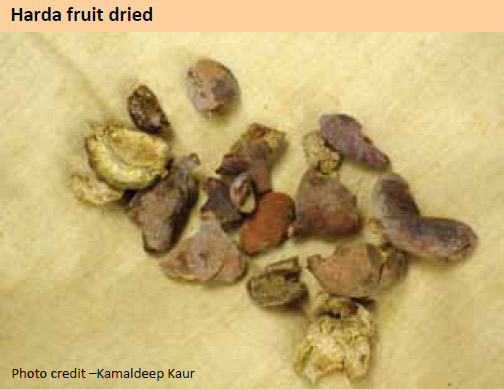
The colour of the metal complex with tannin depends on the metal salt with which tannin is complexed as shown in the following table
Color of metal complex of tannin with different metal salts
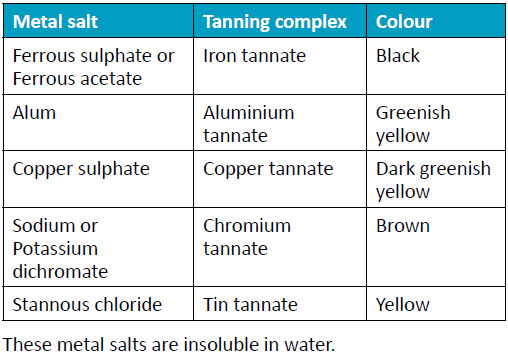
From the natural dyeing point view only Alum and iron salts are environmentally friendly. The other salts like copper sulphate, sodium dichromate and stannous chloride are not environmentally friendly. Therefore, although they are suitable as mordant for natural dyes they are not recommended on environmental and toxicity grounds.
Black and red are the most popular colours produced by block printing of cotton in Rajasthan. The chemistry involved in the production of these colours is summarized below.
Black colour
Treatment of cotton or silk or wool with harda followed by treatment with iron salt is commonly used to produce black colour either during dyeing or printing.
Harda treated fabric followed by subsequent printing with alum is used to produce variety of shades by subsequent dyeing or printing with other natural dyes.
In summary different shades with natural dyes are produced using following sequences
• Black shade
Treatment of fabric with Harda solution Dry Block print with iron salt solution. This sequence is often used to produce black outline of the design.
• Other shades
Treatment of fabric with harda solution Dry Treatment with alum either by printing or treating the whole fabric with alum solution à dyeing or printing with other natural dye source.
During this operation the metal salt chelated with tannin in harda forms another complex with the natural dye source applied by dyeing or printing process
For example when harda treated fabric is printed with alum, a complex between tannin of harda and aluminium is formed. When this fabric is treated with alizarin by dyeing process, the alizarin forms a complex with aluminium with the formation of red colour.
Understanding the above chemistry would help to understand the process of natural dye dyeing or printing practiced in Rajasthan.
Let us now understand the functions/purpose of the different steps of vegetable dye block printing operations from a chemistry point of view
| Step | Process | Purpose/function | Purpose/function |
|---|---|---|---|
| 1 | Scouring | Pre processing of fabric before printing locally called “Hari Sarana” | To make the fabric water absorbent and white which help to produce uniform and bright prints. Chemistry: The improvement in water absorbency and whiteness is due to removal of starch size, natural waxes and natural colouring matters and other impurities. |
| 2 | Tannin or Harda treatment | Preparing fabric for printing locally called “Peela Karna” or Harda Rangai | This is the basic process for the fixation of metal salt mordant applied during subsequent block printing operation. Commonly used mordents are iron to produce black and alum to produce red shades. |
| 3 | Printing | Printing with mordant salts locally called “Chapai”. |
Chemistry: Harda has affinity to cotton like a direct dye and held on the fabric by weak forces of attraction. Subsequently it helps to interact with the metal salt thus helps to bind the metal on the treated product. The reaction product of harda and metal is insoluble in water. Black colour: Black colour is directly produced when iron solution comes in contact with harda. Black colour is due to interaction of tannin in harda with iron metal with the formation of water insoluble iron tannate. Red colour: Reaction between harda and alum does not produce red colour. Harda only helps to retain alum on harda treated fabric in the insoluble form. Red colour is formed during subsequent dyeing process with madder or Alizarin. Since alum is applied in the printed form, Alizarin reacts with alum to form metal complex with Aluminium in alum with the formation of red colour. Purpose of Dhawadi flowers: During dyeing with alizarin, Dhawadi flowers are added in the dye bath. In the presence of these flowers prevent the staining of unprinted portions of fabric with alizarin. |
| 4 | Drying | Drying of printed fabric or Ageing before dyeing the fabric in natural dye locally called “Sukhai” | Drying or ageing process helps to provide sufficient time for the interaction between harda and metal salt to take place so that the metal is fixed on the fabric properly. This is important to get good fastness properties of the colour developed. |
| 5 | Washing | Washing or removal of excess mordant before dying locally called “Khulai” | This step is very important to remove the unfixed metal salt mordant applied during printing operation. If the unfixed mordant is not removed then tinting of ground would take place during subsequent dyeing. For example, if alum mordant is not removed then during subsequent dyeing with alizarin red colour would be produced at printed portion as well as on ground of the fabric. |
| 6 | Dyeing | Dyeing or fixing of colours after washing locally called “Rangai” | This helps to produce red shade at the alum printed portion during subsequent dyeing with alizarin |
| 7 | Resist or Dabu printing | Clay mud printing locally called “Dabu Datai” | The steps 2-6 would produce black (outline) and red (filled) colour design. Additional print effect is produced by Dabu printing |
| 8 | Dyeing with blue colour | Locally called “Neel Rangai” | The Dabu printed fabric is dyed with indigo. In this process white print effect is produced at the Dabu printed portions with blue background. |
| 9 | Dyeing with yellow dye | Locally called “Haldi Naspal Putai” | If yellow colour is desired in the background instead of blue, then dyeing with Haldi +Naspal (Turmeric+ Pomegranate) is carried out. |
| 10 | Post mordant or fixing | Locally called “Fitkari Rangai” | This involves the treatment of yellow dyed fabric with alum solution. During this treatment the natural colouring components present in Haldi and Naspal will react with Aluminium to form water insoluble Aluminium salt and thus making the yellow colour fast to washing. |
| 11 | Final washing | Locally called “Dhulai” to get rid of all the excess dye and resist paste | Final washing helps to remove any unfixed colour, metal salt and ingredients of Dabu paste. This is important to get improved brightness and fastness of colour. Also fabric feel becomes soft. |
Chemistry of indigo dyeing
Indigo is the oldest natural dye used in India since ancient time to produce blue colour on natural fibres. The association of indigo with India is reflected in the Greek word for the dye, indikón (coming from India). The Romans Latinized the term to indicum, which passed into Italian dialect and eventually into English as the word indigo. Another ancient term for the dye is nil from which the Arabic term for blue, al-nil, is derived.
Majority of natural dyes need treatment with metal salt either before or after dyeing/printing operation. Indigo is applied in the absence of mordant producing blue shades with good fastness properties.
The natural indigo dye is extracted from the leaves of indigo plant. The species of the plant cultivated in India is known as Indigofera tinctoria. However, in the absence of availability of natural indigo, block printers use synthetic indigo. The chemical structure of the dye extracted from indigo plant leaves and synthetic indigo is same.
Properties of Indigo
Indigo is insoluble in water and belongs to vat dye class. Before dyeing it must be converted into water soluble form by the process known as reduction in presence of alkali. The dyeing is carried out while indigo is water soluble reduced form. After dyeing the fabric is exposed to air during which the water soluble form of indigo gets converted into original water insoluble form producing blue color on the dyed fabric.
In ancient time the reduction process was carried out in wooden vats, therefore, this class of dye is known as vat dyes. The process of dyeing of cotton with indigo essentially consists of alkaline reduction of indigo into water soluble form known as leuco indigo, dyeing by multiple dips with intermediate air oxidation to convert leuco indigo to its water insoluble form.
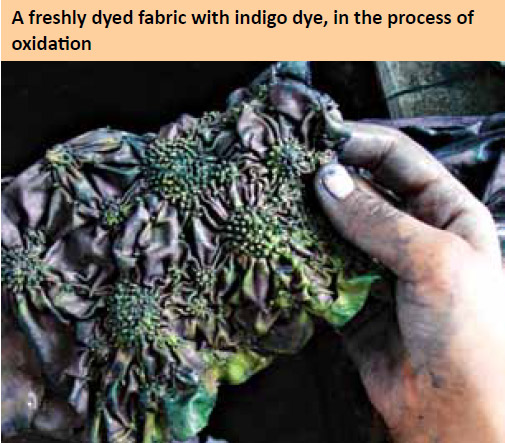
Traditional method of indigo reduction
Fermentation vat
The traditional method is based on the generation of bacteria due to fermentation of organic matter in the content of indigo vat solution. The generated bacteria in presence of alkali are responsible for the conversion of insoluble indigo to soluble form as shown in the above reaction.
The traditional method of indigo reduction varies from region to region and still remains as secrete. Therefore it is difficult to provide exact recipe.
Confirming the indigo reduction
The indigo reduction is confirmed by following tests
- Taking the solution of indigo in a glass container and observing the colour. Yellow green colour of the solution indicates the completion of indigo reduction and ready for use.
- Wet out a piece of bleached cotton fabric into solution, squeeze and expose to air. The process is repeated
- Dip the palm of hand in indigo solution. Take out and then expose to air. Conversion of palm in blue colour indicates indigo reduction.
3 times. Dyeing of cotton fabric in deep blue colour indicates complete reduction of indigo.
Dyeing with indigo
Indigo has poor affinity to cotton, wool or silk. Therefore, deep blue shade on fabric is produced only after repeated dyeing. For this purpose the fabric to be dyed is dipped in reduced indigo solution, squeezed and exposed to air. The procedure of dipping into reduced indigo solution, squeezing and exposure to air is repeated several times (6-10 times) to get deep blue shade. Larger the number of dips, deeper will be the blue colour on fabric.
Leave a Reply